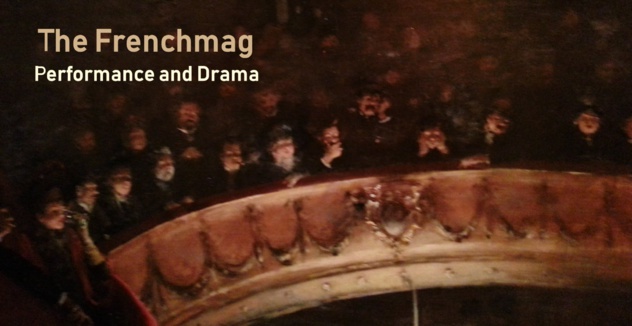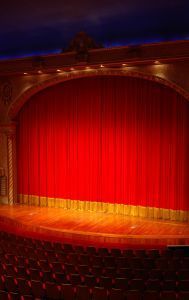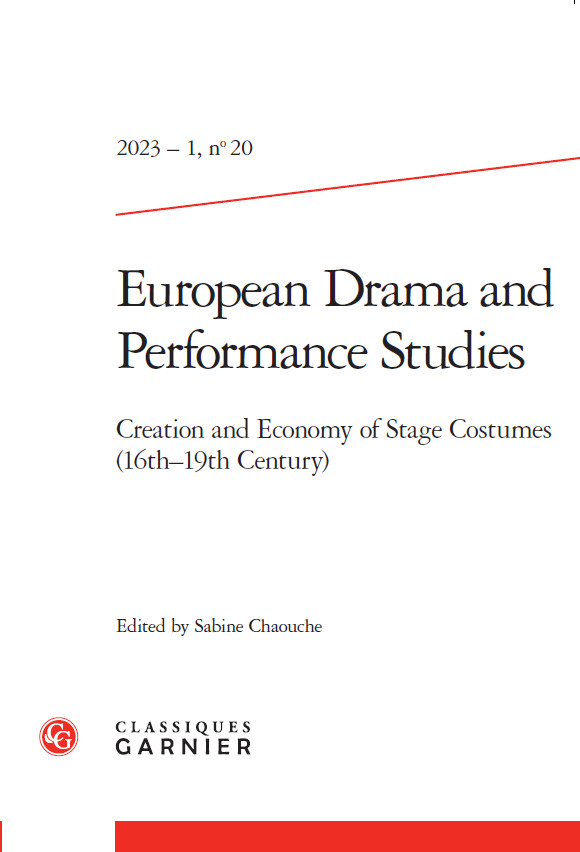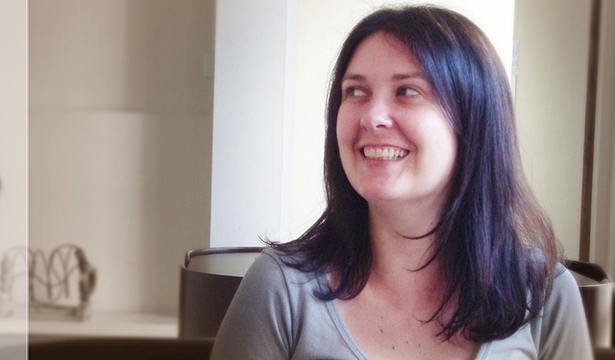
(c) Sabine Chaouche
1. How did you discover theatre?
I was very lucky. When I was at nursery school, at 3 or 4, there was a theatre company called Pentabus (they are still making shows and touring). They used our nursery as a base and a rehearsal space and we used to see their shows. So I have known what theatre was from a very young age which is quite unusual, I think. There were not so many companies that worked for children at the time. Theatre was part of my life from childhood. My parents were very supportive of my interest in theatre and as we lived not too far from Stratford, they used to take me to the Royal Shakespeare Company quite often when I was a teenager. I enjoyed it very much. When I was 13, 14, my school would also organize trips to Birmingham. So I saw quite a lot of fairly traditional drama. Theatre was always part of my life but as an audience member.
2. What was the main influence on you at school or university?
I had a couple of brilliant teachers and one of them was my English teacher. I read English literature with him and he would take us to shows to Stratford in particular. So I have been able to see outstanding performances from an early age. Mark Rylance in Hamlet was for instance particularly a striking experience.
3. Are you influenced today by the performances you saw during your childhood?
Yes, I think so. It is about recognizing that it is quality that matters. That stayed with me. In my childhood, we went also to theatre every summer. There are all sorts of connections.
4. What does your role as Director of the playhouse involve?
It probably is threefold: obviously programming the shows that we have on the main stage here so travelling to other theatres, watching plays there, reading scripts, watching DVDs, talking to producers about what they are going to do in the future and scheduling the shows and putting together seasons, and doing financial negotiations for them. So that is one part. Producing shows ourselves here. We have just appointed a producer so I will be doing a little bit less of that in a hands-on-way but I am still very involved in choosing what we make and create here in Oxford (main theatre, studio, off site work). We have artists in residence and we support them, enabling them to make shows and we work directly with artists to create new works.
And then the other part is the kind of chief executive role which is leading the organization, so looking after the staff here and the relationship with our board of trustees. We are a charity so we have a voluntary board and it is managing that relationship working with our stakeholders, our funders, Oxford University, the Arts Council, the City Council, the County Council.
And then the other part is the kind of chief executive role which is leading the organization, so looking after the staff here and the relationship with our board of trustees. We are a charity so we have a voluntary board and it is managing that relationship working with our stakeholders, our funders, Oxford University, the Arts Council, the City Council, the County Council.
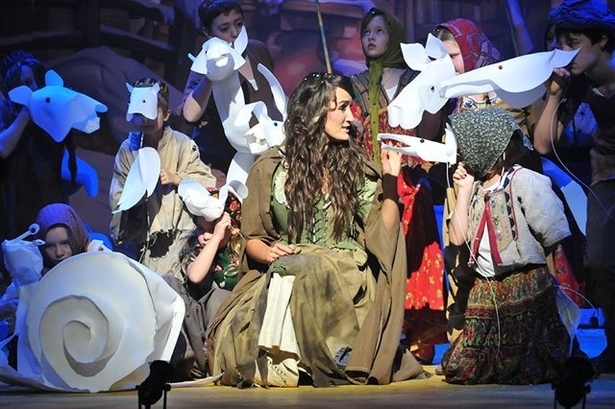
Natalie Tulloch. OP Production of Cinderella. Photo credit: Nick Holmes. 2011. Courtesy of OP.
5. Could you describe a day at the Oxford Playhouse?
If I am here, then I try to spend time with staff because I am not at the theatre everyday but there are always things that people need me to look at, and talk to me about so I might be talking to the team dealing with the youth theatre and the productions they are planning for next year, our marketing team might be working on developing a campaign for one of our own productions, proofing the brochures and I write and rewrite some copies for the shows because often I am the only one who has seen them.
We have information from the theatre companies but we know our audiences so we have got to bring these things all together and often it’s me who tries to do that. I have also lots of emails and mails so being here is just trying to keep up with things. Monday for example I will go to London to have a meeting with the producer of the Globe Theatre to talk about what they will be doing in the future. I also often go to rehearsals. A lot of support to artists is about advocating for them and encouraging them, encouraging other people to see their work and consider them for opportunities. So some days I am in the thick of shows: for instance I recently had to go to Singapore for a premiere at the festival of Singapore and spent three days there. Some other time it is more administrative and pastoral here really.
We have information from the theatre companies but we know our audiences so we have got to bring these things all together and often it’s me who tries to do that. I have also lots of emails and mails so being here is just trying to keep up with things. Monday for example I will go to London to have a meeting with the producer of the Globe Theatre to talk about what they will be doing in the future. I also often go to rehearsals. A lot of support to artists is about advocating for them and encouraging them, encouraging other people to see their work and consider them for opportunities. So some days I am in the thick of shows: for instance I recently had to go to Singapore for a premiere at the festival of Singapore and spent three days there. Some other time it is more administrative and pastoral here really.
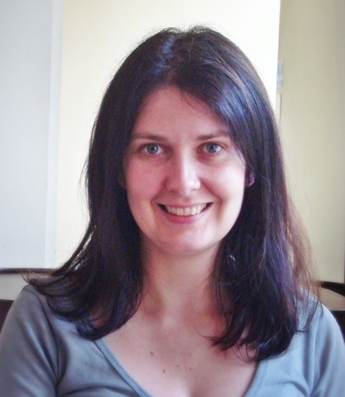
Michelle Dickson (c) Sabine Chaouche
6. What do you enjoy most in your job?
I really like having that direct contact with artists and help them to realize their vision, their dreams but it is really hands on and time consuming. I find that bit hard to juggle with all the other things. I liked the Singapore experience and having three days in the theatre and not having to worry about anything else. Just focusing on the show, watching it six times with the director and audiences. I really liked that but that is the bit which is really hard to make enough time for. And I love finishing work and coming down to the foyer and seeing it full of people who are about to go into the show. I enjoy seeing shows here even when I have seen them elsewhere before, bringing them home and putting them in front of our audiences and see their reactions… It is a very satisfying way to be connected to the world, even if we have not been involved in making most of the shows. However we have lived with them for six months, nine months, seen them, read the script or talked about who is directing and who is designing, what the image is going to look like. We have a good relationship with other companies which come through. So seeing it on the stage and seeing it working is really important. I really like the variety of shows over the year. The audiences are so different. You can go downstairs: it can be full of students or families, or teenagers or older people. It is really special.
7. What makes the playhouse a special theatre and a place different from other playhouses?
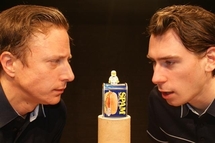
Robin Hemmings and Oliver Millingham. OP Production One Small Step. (c) Charlie Field. Courtesy of OP.
Oxford is not that big a city but none of us are trying to do what the others are doing. Every theatre has its own niche fortunately or we would be treading on each other’s toes. The New Theatre is so much bigger than us. It is really a music hall venue or a concert venue. It is very hard to do drama in that place. Likewise here it is difficult to organize music hall. We do not have enough seats to sell to make it financially viable. So the only time when we are able to do music hall is when local amateur groups or the students do that. It is exciting and fun. What we are aiming for is a high quality programme and the core of that is drama, plays either classical or contemporary. We try as much as we can to diversify our programme so we have comedy, contemporary music, dance, lectures poetry.
The Studio is a real treat and a bonus for us. It only has 50 seats and yet the work is brilliant. I think this theatre needs to be part of the community. That’s how it works best. When there is that flow of different people feeling at home and that this place is doing something special for them it is excellent. So on Mondays mornings we have music sessions for babies and toddlers. It is about recognizing that people of all ages can get some benefit from this building. The building itself should be part of the community as well as what goes on in it: having exhibitions, meetings, events, being parts of Arts week… All these things are really important to us too.
The Studio is a real treat and a bonus for us. It only has 50 seats and yet the work is brilliant. I think this theatre needs to be part of the community. That’s how it works best. When there is that flow of different people feeling at home and that this place is doing something special for them it is excellent. So on Mondays mornings we have music sessions for babies and toddlers. It is about recognizing that people of all ages can get some benefit from this building. The building itself should be part of the community as well as what goes on in it: having exhibitions, meetings, events, being parts of Arts week… All these things are really important to us too.
8. What have you developed more particularly in recent years?
The “Playhouse Plays out” has been developed in that time and that was about recognizing that some people are not finding their way to the theatre. Also artists increasingly are making shows that do not fit into traditional theatre spaces. So it is about trying to be able to work with these innovative, interesting artists and put shows in other places where we might find a different audience. So we have chosen caféd, pubs, parks, rugby pitches, the Botanic Gardens, the quad of the Bodleian Library. It is about trying to open up Oxford as well, so there are lots of amazing locations, some of which are behind closed doors: Christ Church Cathedral or even a student college room in St John’s College. It was probably the first time that some people had been in a room in a college. That is really fun. It is something that we will go on developing because it is really popular.
9. How do you attract new audiences?
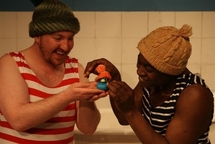
John McGrellis and Matt Christian Reed. OP Production of Bath Time. Photo credit: Charlie Field. Courtesy of OP.
We try all the time to show people that The Playhouse is for everyone. We have staff and volunteers who are passionate about theatre and the shows we put on. We design our brochures very carefully and try to make them really clear and attractive. We work on the language that they might find out off putting. We redecorated the Front of House in a clear, more neutral and fresh contemporary kind of way. We are not denying our heritage but we are also recognizing that people spend their leisure time going to cinema, shopping or sporting events… We need to be on a par with level of experience so we are trying to make the website really straightforward and user friendly.
More interestingly for me, our community engagement work is really core to what we are doing so we raise funds to create this post. We have a community engagement officer, externally. It is not about selling tickets but getting out and meeting people who are currently experiencing what we have to offer and finding ways of bringing them in and finding things they might be interested in. It is a two way process. It is not just us doing marketing and wanting people to come to the OP. It is also listening to people and community groups and trying to find out what they are interested in. Our community officer works with all groups: schools, the big issue sellers… all sorts of people. Giving them free or discount tickets is also a way to welcome them and to show what there is around. I think it is easy when you are familiar with theatre to forget how alien experience it might be if you have never been introduced to theatre.
All our volunteers are brilliant and very welcoming. Having a backstage tour makes you understand how it really works. It is magical and exciting. It has made a real difference to hundreds of people. I am having a brilliant time!
More interestingly for me, our community engagement work is really core to what we are doing so we raise funds to create this post. We have a community engagement officer, externally. It is not about selling tickets but getting out and meeting people who are currently experiencing what we have to offer and finding ways of bringing them in and finding things they might be interested in. It is a two way process. It is not just us doing marketing and wanting people to come to the OP. It is also listening to people and community groups and trying to find out what they are interested in. Our community officer works with all groups: schools, the big issue sellers… all sorts of people. Giving them free or discount tickets is also a way to welcome them and to show what there is around. I think it is easy when you are familiar with theatre to forget how alien experience it might be if you have never been introduced to theatre.
All our volunteers are brilliant and very welcoming. Having a backstage tour makes you understand how it really works. It is magical and exciting. It has made a real difference to hundreds of people. I am having a brilliant time!
10. How do you go about deciding on a show and more generally a whole season?
I get my whole team involved. When we want to produce a show we present it to the Board to get their agreement because it is a big financial investment. We make a proposal and we pitch it. The thing is to see how a season fits; together as a whole and trying to have something for everybody, thinking about that mix of new writing, classic plays, wherever we can trying to have a diverse range of works and diverse voices in terms of ethnicity but also locations. It is hard to do foreign plays but we try to whenever we can. We like to present shows by international companies but obviously it is more expensive because of the costs for bringing them over. We also aim to have contemporary music and dance, and comedy. I have been programming the theatre for nine years now so it feels very natural and I know what audiences we have. There are some kinds of cornerstones in the programme: seven weeks each Christmas are for panto; five weeks of Oxford University students shows each year, at least three weeks of amateur shows; and then two “dark weeks” when we do maintenance.
11. What are your personal hopes for the Playhouse in the next ten years?
I guess to keep growing and it is very hard because we have got a physically constrained site. Over the last three years we have done so much. We are not ready to do more yet but I hope we can carry on doing we do really well. I would love more people to think about this theatre as part of their life. That’s what we try to do everyday.
Interview by Sabine Chaouche
Acknowledgements: Monique Moreton, Stuart Allen, Charlie Field and Madeleine Woolgar for their great help.
Interview by Sabine Chaouche
Acknowledgements: Monique Moreton, Stuart Allen, Charlie Field and Madeleine Woolgar for their great help.
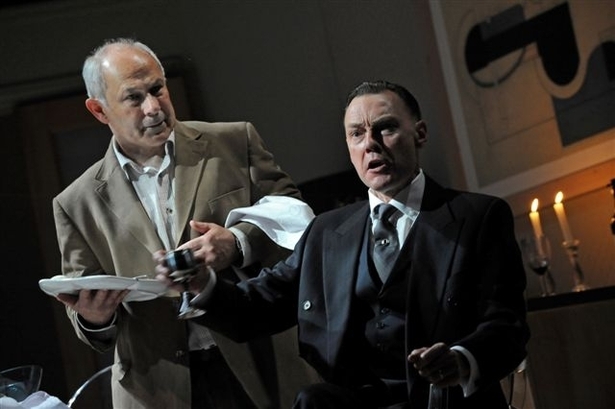
Nicholas Woodeson and Paul Brightwell. OP and Watford Palace Theatre Production of Von Ribbentrop's Watch. Photo credit: Robert DAY. Courtesy of OP.
Links
http://www.oxfordplayhouse.com/
History of the OP by the OP:
Oxford Playhouse is 71 years old, having been built as a repertory theatre in 1938; the last new theatre to be constructed before the war.
The repertory years meant that a resident company of actors performed one play in the evenings whilst rehearsing the next during the day-times. The relentless schedule meant that audiences had the opportunity to see actors such as John Gielgud, Judi Dench, Ian McKellen, Ronnie Barker and Dirk Bogarde perform many roles on the Playhouse stage.
Perhaps the most famous production in the theatre’s history was an Oxford University Dramatic Society’s Dr Faustus in 1966. Alongside the student performers starred Richard Burton and Elizabeth Taylor, perhaps the most famous couple in the world at the time.
Other notable student performers over the years have included Rowan Atkinson, Michael Palin and Dudley Moore, and more recently, Emily Mortimer and Emilia Fox. Students who went on to success in other fields included politicians Shirley Williams and Nigel Lawson, director John Schlesinger and writers Alan Bennett and Christopher Hampton.
Though highly valued locally and held in national regard, the Playhouse often had a precarious financial position, and eventually closed in 1987 due to a lack of funds to carry out essential modernisation. Directors’ Hedda Beeby and Tish Francis were appointed to re-open the theatre, which they managed to do in 1991 after a long fundraising campaign and major refurbishment.
Since then, the theatre has gone from strength to strength, presenting a varied programme of high quality drama, dance, music, comedy, poetry and lectures. Though no longer a repertory theatre, the Playhouse is producing once again.
More at: http://www.oxfordplayhouse.com/aboutus/history.aspx
People: http://www.oxfordplayhouse.com/aboutus/PlayhousePeople.aspx
What's on: http://www.oxfordplayhouse.com/?venue=main
History of the OP by the OP:
Oxford Playhouse is 71 years old, having been built as a repertory theatre in 1938; the last new theatre to be constructed before the war.
The repertory years meant that a resident company of actors performed one play in the evenings whilst rehearsing the next during the day-times. The relentless schedule meant that audiences had the opportunity to see actors such as John Gielgud, Judi Dench, Ian McKellen, Ronnie Barker and Dirk Bogarde perform many roles on the Playhouse stage.
Perhaps the most famous production in the theatre’s history was an Oxford University Dramatic Society’s Dr Faustus in 1966. Alongside the student performers starred Richard Burton and Elizabeth Taylor, perhaps the most famous couple in the world at the time.
Other notable student performers over the years have included Rowan Atkinson, Michael Palin and Dudley Moore, and more recently, Emily Mortimer and Emilia Fox. Students who went on to success in other fields included politicians Shirley Williams and Nigel Lawson, director John Schlesinger and writers Alan Bennett and Christopher Hampton.
Though highly valued locally and held in national regard, the Playhouse often had a precarious financial position, and eventually closed in 1987 due to a lack of funds to carry out essential modernisation. Directors’ Hedda Beeby and Tish Francis were appointed to re-open the theatre, which they managed to do in 1991 after a long fundraising campaign and major refurbishment.
Since then, the theatre has gone from strength to strength, presenting a varied programme of high quality drama, dance, music, comedy, poetry and lectures. Though no longer a repertory theatre, the Playhouse is producing once again.
More at: http://www.oxfordplayhouse.com/aboutus/history.aspx
People: http://www.oxfordplayhouse.com/aboutus/PlayhousePeople.aspx
What's on: http://www.oxfordplayhouse.com/?venue=main
